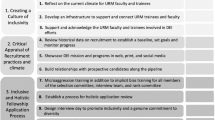Abstract
In a workshop organized by NICHD and the AAP in January 2004, we addressed and discussed issues related to a Hispanic perspective in Training and Retaining of underrepresented minority physician scientists in the United States. A review of the literature related to training of underrepresented minority physicians in the United States (US) was performed, giving emphasis to those related to the Hispanic population. Success and failure in training and retention of Hispanic physician scientists and trainees was examined. An underrepresentation of Hispanic minorities in medical research workforce was found. This fact has recently resulted in efforts to increase their recruitment and there is a mandate by the National Institute of Health (NIH) for their inclusion. The Hispanic population in the US has increased rapidly, with diversity among the Hispanics in their personal and professional behavior. Significant disparities in health, health risk factors and access to health care manifested by an increased burden of illness and death have been documented. There in an undersupply of academic Hispanic neonatologist. Factors such as availability of academic employment, limited research funding in pediatrics, managed care and large debt burden of the US medical graduates interfere with recruitment of Hispanic trainees and academic physician scientist. Possible solutions, including recognition research awards, revision of NIH policies in awarding funds for neonatology, establishing strategies to improve minorities' acceptance, participation in research and increase accrual of Hispanic population in clinical trials should be given priority.
This is a preview of subscription content, access via your institution
Access options
Subscribe to this journal
Receive 12 print issues and online access
$259.00 per year
only $21.58 per issue
Buy this article
- Purchase on Springer Link
- Instant access to full article PDF
Prices may be subject to local taxes which are calculated during checkout


Similar content being viewed by others
References
Shavers VL, Lynch CF, Burmese LF . Knowledge of the Tuskegee study and its impact on the willingness to participate in medical research studies. J Nat Med Assoc 2000; 92(12): 563–572.
Population Reference Bureau, 2000 Census.
FOPE II Pediatric Sub Specialists of Future Workgroup, Final Report.
The Future of Pediatrics Education II Neonatology: Supplement, p 1233.
HHS Fact Sheet, Eliminating Minority Health Disparity, US Department of Health and Human Services, 2000.
American Academy of Pediatrics, Division of Health Policy Research, Periodic Survey of Fellows #43, 2000.
http://www.tulane.edu/~finaid [revised: April 7, 2000].
Wilfred Y, Fujimoto MD . Community involvement and minority participation in clinical research, journal.diabetes.org/diabetesspectrum/98v11n3/pg161.
Author information
Authors and Affiliations
Corresponding author
Additional information
This work was presented in the NICHD-AAP Workshop on Research in Neonatology in January 2004.
Rights and permissions
About this article
Cite this article
Valcarcel, M., Diaz, C. & Santiago-Borrero, P. Training and retaining of underrepresented minority physician scientists – a hispanic perspective: NICHD-AAP workshop on research in neonatology. J Perinatol 26 (Suppl 2), S49–S52 (2006). https://doi.org/10.1038/sj.jp.7211526
Published:
Issue Date:
DOI: https://doi.org/10.1038/sj.jp.7211526
Keywords
This article is cited by
-
Seeking racial and ethnic equity among neonatologists
Journal of Perinatology (2021)
-
Impact of Race Versus Education and Race Versus Income on Patients’ Motivation to Participate in Clinical Trials
Journal of Racial and Ethnic Health Disparities (2018)
-
Research Professionals’ Perspectives, Barriers, and Recommendations Regarding Minority Participation in Clinical Trials
Journal of Racial and Ethnic Health Disparities (2017)
-
Racial Differences Among Factors Associated with Participation in Clinical Research Trials
Journal of Racial and Ethnic Health Disparities (2017)


